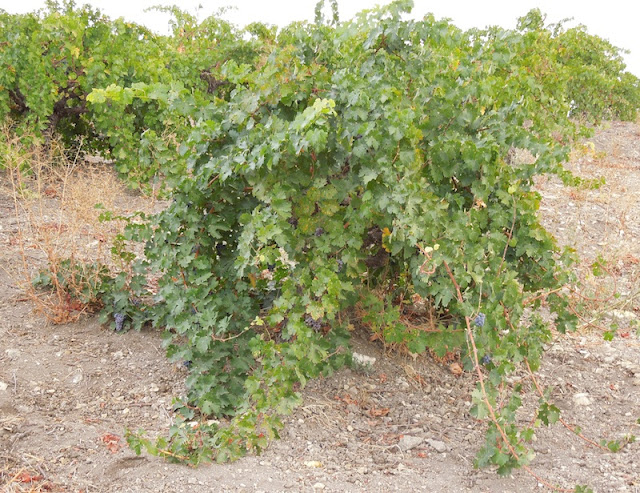 |
| Photo of Zinfandel Grapes in Vineyard at Castoro Cellars, © B. Radisavljevic |
Another neighbor, Peachy Canyon Winery, is also known for its Zinfandel wines. It had at once time a small demonstration vineyard across from the tasting room that grew some Zinfandel grapes. See it below.
 |
| Photo of Zinfandel Grapes in Small Vineyard at Peachy Canyon Winery, © B. Radisavljevic |
The last photos I will feature of Zinfandel grapes are from another close neighbor, Rotta Winery. I can climb their hill and look down and see my house. Unlike the other vines I showed you from Castoro and Peachy Canyon, the Rotta vines are head-trained. They can look a bit wild when they are at their leafiest, but I like them. Here is a vine I photographed as grapes were fairly ripe.
 |
| Photo of Head-Trained Zinfandel Grapes from Rotta Vineyard, © B. Radisavljevic |
Below is a close-up of the leaves and fruit.
 |
| Photos of Almost Ripe Zinfandel Grapes from Rotta Vineyard, © B. Radisavljevic |
If you found this post interesting, please share it. The sharing buttons are just above the comment box at the end of the post. The photo below is especially designed for pinning. All photos in the collage were taken at Peachy Canyon Winery.
This is my last post for the 2016 AtoZchallenge, a Blogging Challenge for the month of April, 2016. My theme is plants, since this is a gardening blog. Here are links to the other posts if you missed them.
A is for Apple Blossoms
B is for Bottlebrush
C is for Carnations
D is for Daisy
E is for Elderberry
F is for Flowers
G is for Gazania
Hollyhocks are Edible
Irises Are Garden Survivors
Jupiter's Beard: A Mystery Finally Solved
Kale for Lunch
Lion's Tail - A Perennial Summer Burst of Orange
Miner's Lettuce is Tasty and Free"Naked Ladies" Bloom in August
Oleander through the Year
Plant Pests and their Predators: Aphids and Ladybugs
Quince Fruit from Blossom to Table
Roses Are Not Just Red
Sages Add Color and Attract Beneficial Insects to Your Garden
Tansy and Fruity Teucrium Can be Garden Friends
Urushiol Will Make You Itch
Vetch Runs Wild
Weeds I Love to Hate
Xeriscaping is Essential in Dry Areas






No comments:
Post a Comment